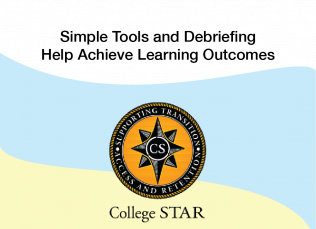
Simple Tools and Debriefing Help Achieve Learning Outcomes
This Case Study highlights the practice of using low-barrier, low-resource instructional tools, such as children’s puzzles, to achieve targeted learning outcomes which are realized through a facilitated debriefing process.
This resource was originally developed with resources from the College STAR grant. That grant has ended and the College STAR modules will now permanently reside at the East Carolina University Office for Faculty Excellence.
Module Introduction
This Case Study will teach facilitators how to use low-barrier, low-resource instructional tools such as children’s puzzles to achieve targeted learning outcomes which are realized through a facilitated debriefing process. We explain and explore how to use puzzles in multiple ways as an activity, that when followed by a facilitated debrief, aids learners in translating and transferring the experience to their own lives, and in some cases, professional disciplines. These debriefs can be mapped against external competency and skill domains, as well as Bloom’s Taxonomy for learning. Additionally, they are consistent with principles of Universal Design for Learning by providing responsive learning opportunities geared to participants’ understanding, adapted to any audience.
There are many low-barrier, low-resource instructional tools to engage learners in skill-building for collaborative teamwork. Through the use of children’s puzzles, which are completed by putting like contours of the pieces together (as in a jigsaw puzzle) we demonstrate how to utilize a single, inexpensive resource to provide team-based experiences in multiple ways while debriefing them to target different learning objectives. The techniques can be used by teachers/facilitators in face-to-face classroom or training environments and can be readily adapted as well to both synchronous and asynchronous teams in online teaching environments. The tasks themselves require no prior experience or training for participants, thus leveling opportunities for success among learners.
While we use these in graduate-level health professions education, we have had similar successes with high school students as well as professionals in their respective fields of expertise. We believe these activities are relevant to other fields and disciplines, as well, such as when teaching group negotiation processes in a business course or communication skills within any field. Ultimately, skills learned through this module are easily applicable to other, similar activities to broaden opportunities for student engagement in learning, and several additional low-barrier, low-resource ideas are included in this discussion. The reader takes away an understanding of the model and process for using these tools and should be able to apply easily attainable, inexpensive resources at hand to immediately implement this approach.
Support for this Module
Original development of this module was made possible by the College STAR (Supporting Transition Access and Retention) initiative. College STAR was a grant-funded project focused on partnering postsecondary educational professionals and students to learn ways for helping postsecondary campuses become more welcoming of students with learning and attention differences. Much of this work was made possible by generous funding from the Oak Foundation.
Organization/Publishers:
Share this resource:
Posted date:
March 21, 2024
